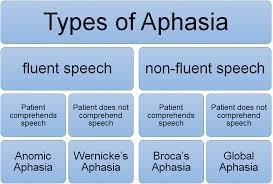The nurse is assessing a patient with suspected neurological issues. The patient's speech is delivered with normal rhythm but filled with words that do not form any meaningful statements.
The patient is also unable to write or repeat back words and does not appear to understand the nurse's instructions or questions. The nurse would recognize these symptoms as:
Expressive aphasia
Broca's aphasia
Global aphasia
Wernicke's aphasia
The Correct Answer is D
Choice A rationale: Expressive aphasia is a type of non-fluent aphasia that affects the
ability to produce language. It is caused by damage to the anterior part of the left frontal lobe, which is responsible for motor planning and execution of speech. Patients with expressive aphasia can understand language but have difficulty speaking, writing, or naming objects. They often produce short, halting, and grammatically incorrect sentences with word-finding difficulties.
Choice B rationale: this is another term for expressive aphasia. The patient can
understand language but have difficulty speaking, writing, or naming objects. They often produce short, halting, and grammatically incorrect sentences with word-finding difficulties.
Choice C rationale: Global aphasia is a severe form of aphasia that affects both
comprehension and production of language. It is caused by extensive damage to the left hemisphere of the brain, which is dominant for language functions in most people.
Patients with global aphasia have little or no ability to speak, write, read, or understand language.
Choice D rationale: Wernicke's aphasia is a type of receptive aphasia that affects the
comprehension and production of language. It is caused by damage to the posterior part of the left temporal lobe, which is responsible for processing auditory and visual
information. Patients with Wernicke's aphasia can speak fluently but nonsensically, using words that are irrelevant, invented, or distorted. They also have difficulty understanding spoken or written language and following commands.

Nursing Test Bank
Naxlex Comprehensive Predictor Exams
Related Questions
Correct Answer is C
Explanation
Choice A rationale: This question is not relevant to BPH, as erectile dysfunction is not a common complication of this condition. Erectile dysfunction can have other causes, such as cardiovascular disease, diabetes, medications, psychological factors, or aging.
Choice B rationale: This question is not relevant to BPH, as penile discharge is not a symptom of this condition. Penile discharge can indicate an infection, such as sexually transmitted diseases, urinary tract infections, or prostatitis.
Choice C rationale: BPH is a condition that causes enlargement of the prostate gland, which can obstruct the flow of urine and cause symptoms such as difficulty in starting or stopping urination, weak or intermittent stream, dribbling, and incomplete bladder emptying. Asking about the force of the urinary stream can help assess the severity of BPH and the need for treatment.
Choice D rationale: This question is not relevant to BPH, as sexual function is not directly affected by this condition. However, some men with BPH may experience reduced libido or satisfaction due to urinary symptoms or psychological distress.
Correct Answer is B
Explanation
Choice A rationale: Used primarily for gout and familial Mediterranean fever, not for Paget's disease.
Choice B rationale: Alendronate is a bisphosphonate commonly used to manage Paget's disease by slowing down bone breakdown and reducing the risk of complications.
Choice C rationale: Prednisone is a corticosteroid used for various inflammatory conditions but not typically prescribed for Paget's disease.
Choice D rationale: Used to lower uric acid levels and prevent gout attacks, not a primary medication for Paget's disease.
Whether you are a student looking to ace your exams or a practicing nurse seeking to enhance your expertise , our nursing education contents will empower you with the confidence and competence to make a difference in the lives of patients and become a respected leader in the healthcare field.
Visit Naxlex, invest in your future and unlock endless possibilities with our unparalleled nursing education contents today
Report Wrong Answer on the Current Question
Do you disagree with the answer? If yes, what is your expected answer? Explain.
Kindly be descriptive with the issue you are facing.
